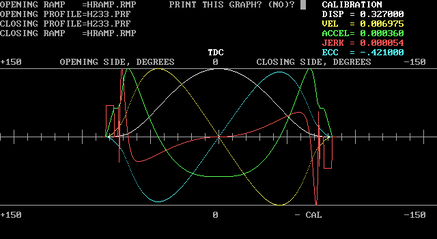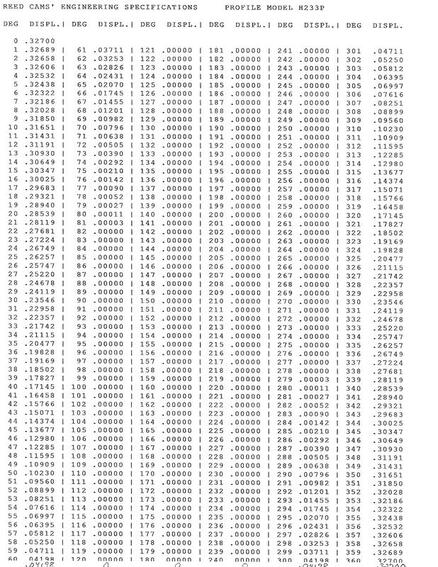|
This is an actual Reed profile designed with this software many years ago. It can be used as a starting point and then go in any direction you like. This is the best way to start learning, just plug in different numbers and look at the results. You will eventually see patterns and learn what inputs do what. It was one of the few cam design programs at the time but it works the same as any polynomial program today. If you didn't keep your MS-DOS computer and printer this software will also run using DosBox-X on a modern computer. I am using DosBox-X for these lessons. I put everything on a flash drive and that basically creates a DOS computer on the flash drive. The DosBox-X program is free to download (https://dosbox-x.com/).
The last stage in the design process is to combine the four sections together and create the finished lobe profile. The four sections are the (1) opening ramp (2) opening profile (3) closing profile (4) closing ramp. Being able to design each one of these sections separately gives the user a lot more control over the lobe design. Not all programs are written this way. Since this is a symmetrical profile the four sections are not needed but when designing an asymmetrical profile they are very necessary. When designing the ramps and profiles you will need to name and save them. The last stage in the process will use those names. Just follow the program instructions to combine the four sections and create the finished cam profile. The output data will be a graph of the profile and the lift table in 1-degree increments printed on one piece of paper handy for milling a model lobe. The lift table can also be manually programmed into a CNC machine or converted into an .s96 file. The last program (readdata.exe) in the software package will display and print the ramp and profile design data that has previously been saved. Ramps are saved with a .rmp extension and profiles have a .prf extension. Overall the lobe design process is not that difficult but certain profiles can be time consuming to design. Again, it is a trial and error process.
2 Comments
Alf8772
1/16/2024 20:55:13
Good evening, Mr Ingram. I have read all your articles and have learned a lot about camshaft design. I'm very interested in your cam profile design class.
Reply
Michael Ingram
1/17/2024 15:50:05
Good to hear. Thank you.
Reply
Leave a Reply. |
Archives
July 2024
|

